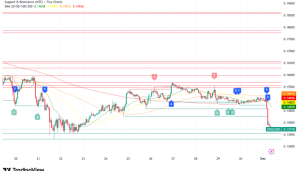Bitcoin’s $19 Billion Leverage Liquidation Sparks Market Recalibration

Bitcoin recently experienced a massive $19 billion liquidation of leveraged positions, sending shockwaves through the cryptocurrency market and prompting a reassessment of risk exposure among investors. This event, driven by a combination of high leverage, volatile price swings, and speculative trading, underscores the inherent vulnerabilities of crypto markets. While such liquidations often trigger short-term volatility, they can also serve as a market reset, allowing for healthier price discovery and consolidation. Analysts highlight that disciplined risk management and diversification are crucial in navigating these cycles, particularly as Bitcoin continues to attract institutional and retail interest amid evolving macroeconomic conditions.
1. Anatomy of the Liquidation Event
The $19 billion liquidation reflects the cascading impact of highly leveraged positions in Bitcoin trading. Traders using borrowed capital to amplify exposure were forced to close positions as prices moved against them, triggering automatic margin calls across exchanges. The rapid unwind intensified price swings, causing temporary dips and heightened market anxiety. Such leverage-induced volatility emphasizes the risks associated with speculative trading, especially in markets that operate 24/7 and are sensitive to sentiment-driven dynamics.
2. Market Implications and Reset Dynamics
While substantial liquidations often provoke panic, they can also facilitate a market reset. Forced position closures remove excess speculative pressure, enabling more sustainable price levels to emerge. Following this $19 billion unwind, analysts note that the market may enter a consolidation phase, offering long-term investors an opportunity to reassess entry points. This recalibration is critical in establishing more balanced supply-demand dynamics, which can improve stability in subsequent trading cycles.
3. Risk Management and Investor Takeaways
Events of this magnitude serve as a stark reminder of the importance of prudent risk management. High leverage can amplify gains but equally magnifies losses, and market participants must align exposure with risk tolerance. Diversification, stop-loss strategies, and measured position sizing are increasingly recommended by financial analysts to navigate cryptocurrency volatility. Investors should approach Bitcoin with a long-term perspective, acknowledging both its transformative potential and susceptibility to abrupt market swings.
4. Institutional Participation and Market Evolution
Despite the volatility, Bitcoin continues to attract institutional interest, from hedge funds to corporate treasury allocations. These players often employ more sophisticated risk controls and hedging mechanisms, providing a stabilizing influence amid retail-driven liquidations. As institutional participation grows, market infrastructure—liquidity provision, custody solutions, and regulatory compliance—will continue to mature, potentially mitigating the severity of future leverage-induced disruptions.
5. Outlook for Bitcoin and the Crypto Market
The recent $19 billion leverage wipeout highlights both the risks and resilience of the cryptocurrency ecosystem. Short-term volatility is likely to persist, but seasoned investors view such events as opportunities for strategic accumulation. As regulatory clarity and market maturity evolve, Bitcoin may experience greater stability while retaining its appeal as a high-growth, digital store-of-value asset. Careful navigation, informed decision-making, and a focus on long-term fundamentals remain key for participants seeking to benefit from the digital asset’s ongoing evolution.
Conclusion:
Bitcoin’s recent leveraged liquidation underscores the dynamic and often unpredictable nature of cryptocurrency markets. While $19 billion in forced position closures rattled investors, the event also initiates a market recalibration that may strengthen future price discovery. For both retail and institutional participants, disciplined risk management and strategic allocation remain essential, reinforcing the need to balance high-growth potential with prudent financial stewardship in the evolving digital asset landscape.




